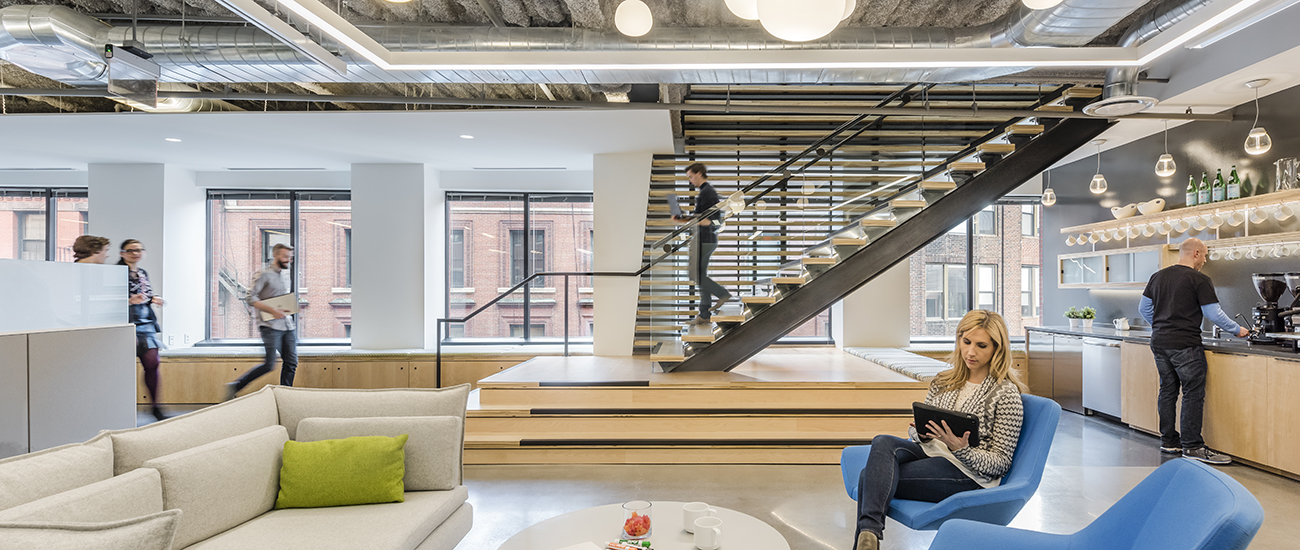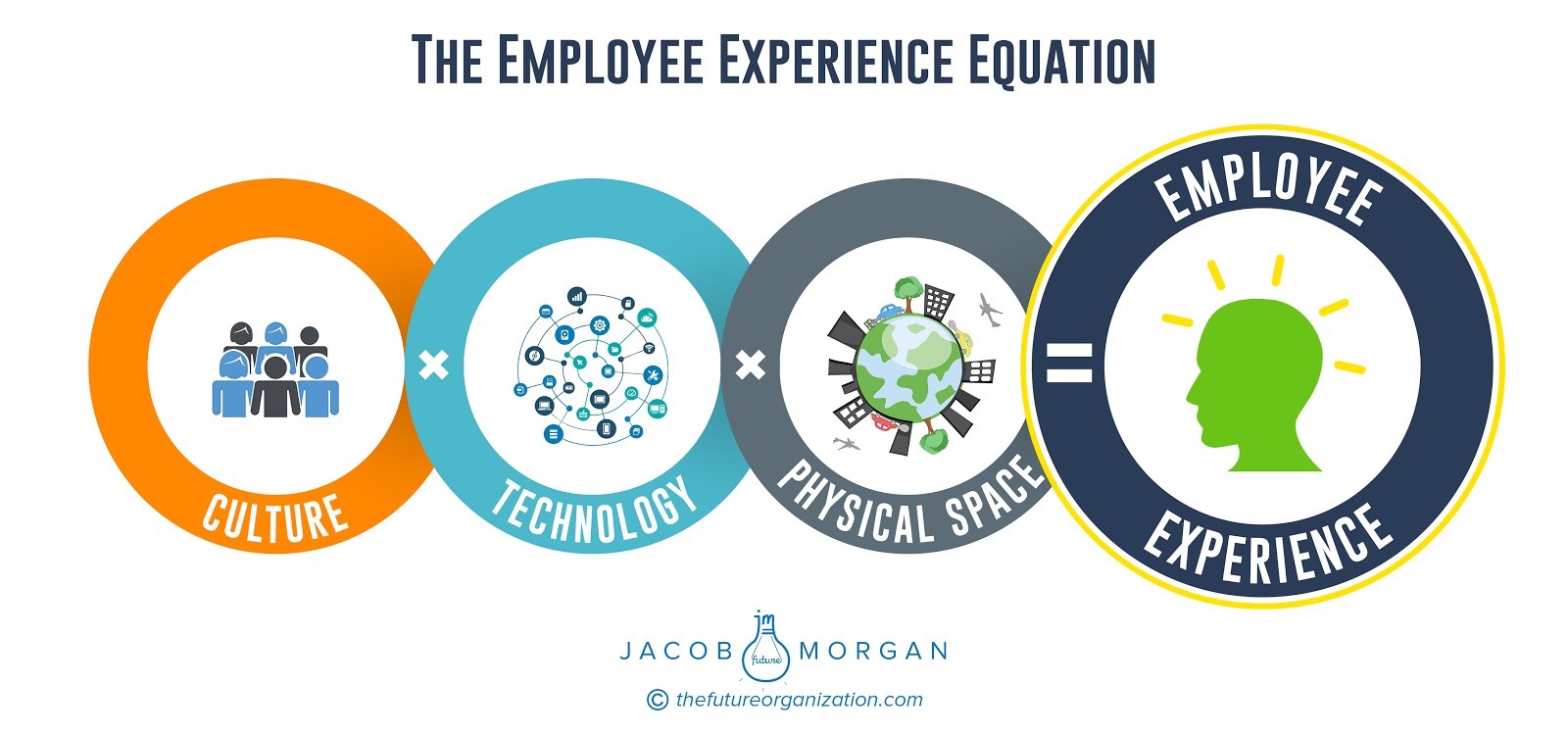WeWork Won’t Work for All
Sasaki's Colleen Barrett and Meredith McCarthy discuss the limitations of co-working office spaces used as corporate offices
 Sasaki
Sasaki

There is a lot of talk in popular culture right now about workplace design. People are concerned about everything from the location of their office to whether they have a desk and even whether they have a job. It is time to think about workplace design at a higher level as a business decision. Combining Liz’s 25+ years of workplace design experience and Jacob Morgan’s extraordinary research into the future of work, here are some great tips to create a successful workplace.
Psychologically it is a tough time to be an employee due to our economic shift to an ideas economy. According to the Bureau of Labor Statistics TED Report from June 2017, only 27.7% of occupations no longer require a degree past high school and requirements for a master’s degree, post-secondary work, and a doctoral degree are rising at a rate nearly twice that of other occupations.
We also hear in the media that robots and artificial intelligence (AI) are coming for our jobs and there is rampant speculation around which field is next to be replaced by machines. But this is symbolic of a move to a new economy. Remember the luddites destroying the machines in cotton mills that threatened to take over their jobs? Of course you don’t, but we didn’t stop innovating with the cotton gin nor the Gutenberg Press and we won’t stop now. We can’t prepare for uncertainty in the future but we can design to inspire employees and create a more effective workplace.
In Jacob’s latest book, The Employee Experience Advantage, he studied 252 companies from around the world and found that when it comes to physical space there are four criteria organizations can use to determine if they have a great space. These are abbreviated with the acronym COOL as seen in the image below.

Research has shown that the physical space not only acts a symbol of your organization but also connects an employee’s sense of belonging and connection back to the organization.
Like it or not, your space is symbol of your company. By understanding three aspects of your company you can design an office that creates that symbol that unites and inspires your team:
A good design project is actually a beautiful business decision. It has to be more than just putting nice finishes in a space, giving everyone candy and games. No one comes to work wanting to do a bad job so how can we give employees the space they need to work at their best and be inspired every day?
Sasaki has developed a set of data gathering and analysis tools to quickly understand space, how teams are meeting, what spaces are successful, and how to plan spaces that drive these desired behaviors. As we move to this new economy the creation of ideas is important. This is part of the drive toward collaboration. But equally important are the areas where people can focus and synthesize the ideas that have been created through collaboration. Our tools can help us to understand not only how you are working now, but also how you want to work in the future.
This miss that so many architects and designers make is the reason why there is a lack of satisfaction in many workplaces today. Looking at statistical data the most important spatial need reported by individuals of any age is the need for individual focused work space. Yes, this was the most important space regardless of a respondent’s age—more important than meeting space, collaboration space, the lunchroom—you name it. People want to come to work to work and do not want to have to take projects home as homework. Let’s design workplaces where people have the ability to represent themselves by bringing in things that are special to them, not necessarily in an office, but in a place where teams truly come together. Lisa Nickerson, founder and principal of Nickerson PR & Real Estate Company, recently gave up what she calls her “trophy office” and couldn’t be happier with the results. This doesn’t mean that her photos and awards aren’t displayed, they just aren’t kept in a private office.
When you give employees multiple places to work this leads to higher employee satisfaction and higher productivity. The Leesman Index, which is the world’s largest independent database on workplace effectiveness has found that employees who have flexibility, with a high degree if choice around where they work during the day, have a much higher level of satisfaction than people who are in a private office, a cubicle, or have otherwise limited choice around where to work. This does not mean your choice is limited to working at the office, at Starbucks or at home; rather, this means you have a variety of spaces to choose from that meet the needs of what you are working on that day. Your range of choices could include a quiet car, a group space, a private office, a team room, a meeting room or even a cubicle. And this is why the move to an ideas based economy does not drive real estate usage to a new low. This element of choice embedded within an office setting is the element companies are most often missing in their attempts to create spaces with buzz and activity.
An Experiential Organization (ExpO) is one that has been (re)designed to truly know its people and has mastered the art and science of creating a place where people want, not need, to show up to work. The ExpO does this by creating a Reason for Being and by focusing on the physical, technological, and cultural environments. Culture comprises 40% of an employee’s overall experience whereas technology and physical space both comprise 30% of the overall employee experience. The important thing to remember is that all three of these things impact and influence each other. Technology impacts space, culture impacts technology, space impacts culture, etc. Any decision an organization makes should be funneled through these three lenses which, together, form The Employee Experience Equation.

When Sasaki designed a new headquarters project for Osram, a world leader in LED lighting technology, the initial directive was to design a space with light. The design team created a plan that was inspired by a beacon of light and highlighted their cutting edge design lab and lighting technology. Upon completion, employees reported they were eager to bring friends and family to work for the first time because they were so excited to show their work day passion to their loved ones. In addition, products to market increased 250% the first year Osram occupied their new space.
Simply focusing on perks or benefits creates a dangerous culture inside of your company because it conditions employees to be there because of things they get as opposed to the value that they get and contribute. It’s like being in a relationship with someone simply because they buy you nice things. What happens when one day that person can’t buy you nice things? You leave! In psychology there is a concept known as the hedonic treadmill which basically states that we as humans adapt. So the free food or the hot yoga might seem cool for a while but eventually we get used to it and becomes standard and we’re left wondering, “what’s next?” Focus on changing the core workplace practices inside of your organization instead of just sprinkling perks on top of an outdated work experience.
The result of creating space that reflects your organization’s values can be seen in Sasaki’s design for Cambridge Consultants. This innovative product development and technology consulting company needed space that would convey the breadth of their services and areas of expertise to potential clients. The space needed to communicate to their clients that they would not simply advise them, but also deliver a product that worked and is beautifully designed. Through truly understanding these business drivers Sasaki designed a space that shows off not only the end-product, but also their work process, to illustrate their collaborative process. As a plus, staff recruitment in a difficult hiring market nearly doubled after they moved into their new space.
In a technology-driven world we still need human organizations and the best way to create those is by investing in employee experience. There used to be a time when people had to convince organizations why they be hired. Now, your organization is the one that needs to convince people why they should work there. It’s a complete shift in how we think about attracting and retaining people. We all deserve to work for an organization that invests in employee experience. Wouldn’t you want to work for that kind of a company?
Elizabeth (Liz) is an interior designer with over 25 years of experience designing retail, restaurants, multi-family housing, and workplaces. Liz is particularly interested in understanding how people work together and how to design for collaboration and interaction.
Jacob Morgan is a three time bestselling author, speaker, and futurist who explores the future of work, employee experience and the future of leadership.
Sasaki's Colleen Barrett and Meredith McCarthy discuss the limitations of co-working office spaces used as corporate offices
Our Elizabeth Von Goeler was recognized by the IIDA as a major force for elevating the quality of design within the region, as well as being a strong advocate for professional development